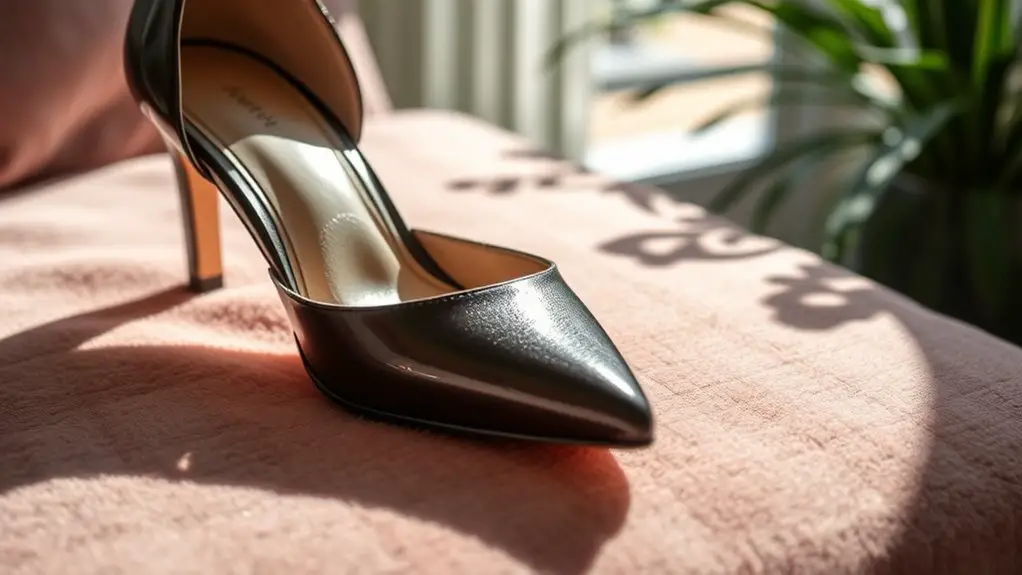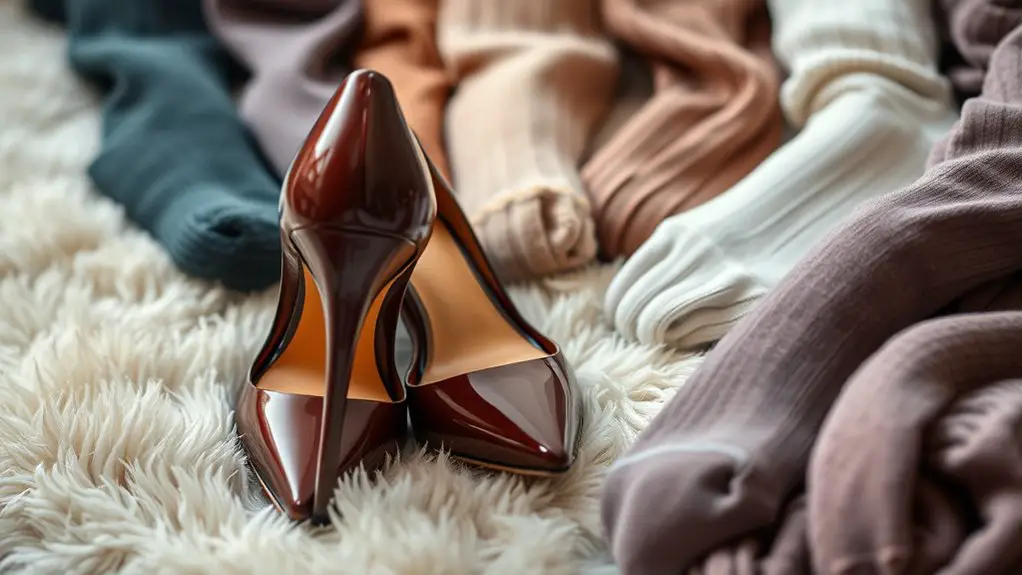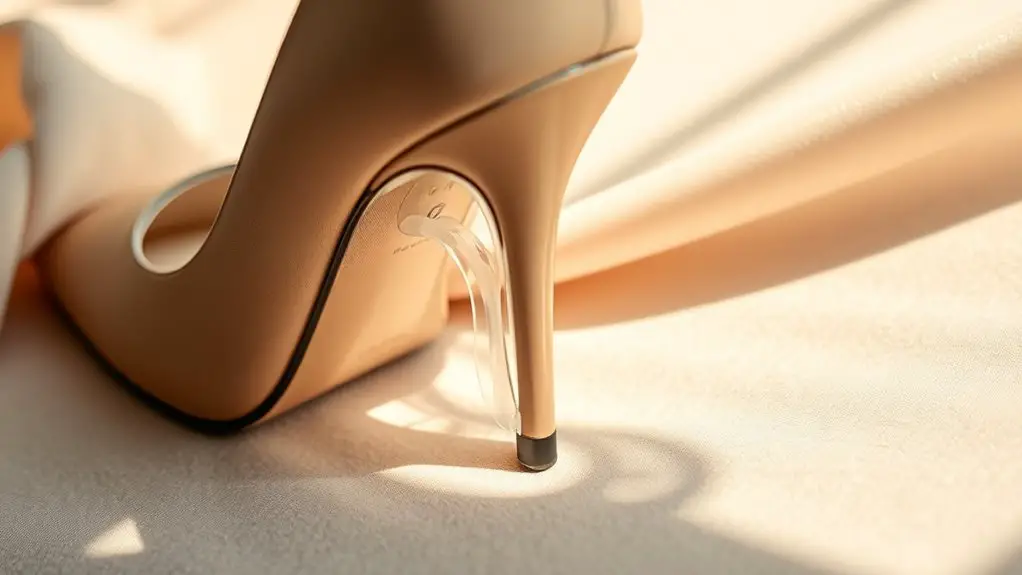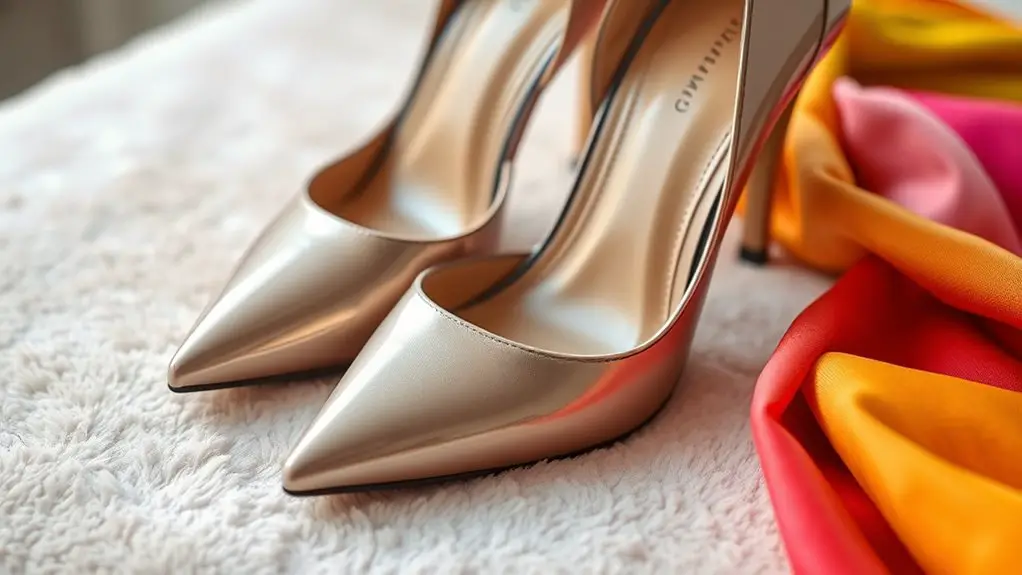To add cushioning to your heels for extra comfort, start by choosing the right insole, like gel or memory foam, which molds to your foot. Consider using gel cushions or arch support inserts to reduce pressure and enhance stability. Selecting the right socks can further improve comfort. Don’t forget to use heel grips for a snug fit while preventing slippage. Explore quality footwear designed for support and cushioning to elevate your overall experience. More tips await you ahead.
Choose the Right Insole

Choosing the right insole is vital for enhancing comfort in heels. When selecting an insole, pay close attention to insole materials and thickness. Common materials include foam, gel, and memory foam, each offering different levels of cushioning and support. Foam is lightweight and provides decent shock absorption, while gel insoles tend to offer superior cushioning and help reduce pressure on your feet. Memory foam molds to your foot shape, delivering customized comfort.
Insole thickness also plays an important role. Thicker insoles typically provide more cushioning but can alter the fit of your heels. You’ll need to guarantee that the added thickness doesn’t make your shoes too tight or uncomfortable. Consider trying various combinations of materials and thickness to find the perfect balance for your unique needs. A well-chosen insole can dramatically improve your experience, allowing you to enjoy your heels without sacrificing comfort.
Use Gel Cushions or Pads
Using gel cushions or pads can greatly enhance the comfort of your heels. There are various types available, each designed for specific applications and foot types. Understanding their benefits and how to apply them correctly will help you maximize their effectiveness for improved foot comfort.
Types of Gel Cushions
Gel cushions, often referred to as gel pads, come in various types designed to enhance comfort in high-heeled shoes. You’ll find them made from different materials, each offering unique benefits. For instance, silicone gel pads provide excellent shock absorption and durability, while polyurethane gel pads are lighter and often more breathable.
When selecting a gel cushion, consider the gel thickness: thinner pads offer discreet comfort, while thicker ones provide more cushioning for long periods of wear. Some gel cushions are specifically designed for the ball of the foot, while others cover the entire insole area. Choosing the right type can greatly impact your overall comfort, helping to alleviate pressure points and prevent foot fatigue.
Application Techniques Explained
When applying gel cushions or pads, it’s important to guarantee proper placement for maximum comfort and effectiveness. Here are some application methods to take into account:
- Clean the Surface: Ascertain the area where you’ll place the cushioning materials is clean and dry for better adhesion.
- Position Correctly: Align the gel cushion or pad so it covers the heel area without overlapping the sides of your shoe.
- Press Firmly: After positioning, press down firmly to secure the cushion in place, assuring it won’t shift during use.
- Test for Comfort: Walk a few steps to confirm the fit and comfort level; adjust as necessary to achieve ideal support.
Following these steps will help you enjoy the advantages of gel cushioning materials effectively.
Benefits for Foot Comfort
Adding cushioning to your heels not only enhances comfort but also contributes considerably to overall foot health. By using gel cushions or pads, you can alleviate pressure points, reduce fatigue, and improve your stability. This comfort enhancement leads to better posture and can prevent long-term foot issues.
| Benefit | Description | Impact on Foot Health |
|---|---|---|
| Pressure Distribution | Evenly spreads weight across the foot | Reduces risk of pain and injury |
| Shock Absorption | Minimizes impact with each step | Protects joints and ligaments |
| Enhanced Stability | Improves grip and balance | Decreases chance of slips and falls |
Incorporating these pads into your footwear routine can considerably improve your daily comfort and promote healthier feet.
Opt for Arch Support Inserts
Opting for arch support inserts can considerably enhance the comfort of your heels. These inserts provide essential support, reducing stress on your feet and improving overall posture. Here are some key arch support benefits and styles to take into account:
Arch support inserts can greatly improve heel comfort by providing essential support and enhancing overall posture.
- Enhanced Comfort: Reduces foot fatigue during prolonged wear.
- Improved Stability: Keeps your foot aligned, minimizing the risk of injury.
- Variety of Styles: Available in gel, foam, or custom-molded options to suit different needs.
- Easy Installation: Most inserts can be easily placed into your existing footwear without modifications.
When selecting arch support inserts, verify they fit well within your heels. Assess the arch support styles that best match your foot type and lifestyle. This tailored approach will not only provide immediate comfort but also contribute to long-term foot health. Investing in proper inserts can make a significant difference in how you feel throughout the day.
Select the Right Socks or Stockings

Choosing the right socks or stockings can further enhance your comfort while wearing heels. The materials and thickness of your socks play an essential role in cushioning and support. Here’s a quick reference table to help you decide:
| Sock Material | Thickness | Benefits |
|---|---|---|
| Cotton | Medium | Breathable and soft |
| Wool | Thick | Insulating, great for colder months |
| Nylon Blend | Thin | Lightweight, ideal for dressy occasions |
| Bamboo | Medium | Moisture-wicking and odor-resistant |
| Compression | Varies | Enhances circulation, supports arches |
When selecting socks, consider how the material interacts with the fit of your heels. Thicker socks provide more cushioning but may alter the snugness of your shoe. Conversely, thinner options offer a sleek look but less padding. Prioritize comfort to guarantee an enjoyable experience with your heels.
Break in Your Heels
When you purchase a new pair of heels, it’s essential to break them in properly to avoid discomfort during wear. Using effective comfort techniques can make a significant difference. Here are some strategies to contemplate:
- Wear them around the house: Start with short periods to allow your feet to adjust.
- Use heel stretching: Gently stretch the heel area by wearing thick socks while walking around.
- Walk on different surfaces: Alternate between carpet and hard floors to help the material flex.
- Apply leather conditioner: If your heels are leather, this can soften the material and aid in the break-in process.
Consider Heel Grips

When you’re looking to improve comfort in your heels, heel grips can be a game changer. There are various types available, each designed to suit different shoe styles and fit issues. Understanding how to apply them effectively can enhance your overall wearing experience and prevent slipping.
Types of Heel Grips
Heel grips come in various types, each designed to enhance comfort and prevent slipping in your shoes. Understanding the different heel grip types and their cushion materials can help you choose the right one for your needs. Here are some common options:
- Gel Grips: Made from soft gel, these provide excellent shock absorption.
- Foam Grips: Lightweight and breathable, foam grips offer a softer feel.
- Silicone Grips: Durable and flexible, silicone grips mold to your heel for a secure fit.
- Leather Grips: Often used in high-end shoes, leather grips add a touch of luxury while providing cushioning.
Application Techniques
Applying heel grips effectively can make a significant difference in your comfort while wearing shoes. Start by gathering your application tools, like scissors, a clean cloth, and rubbing alcohol. First, clean the inside of your shoe’s heel area with the cloth and alcohol to guarantee proper adhesion. Next, measure and cut the cushioning materials to fit your heel shape, allowing for a snug application. Peel the adhesive backing off the heel grips and carefully position them in the shoe, making sure they align with your heel. Press firmly to secure them in place. Finally, let the adhesive set for a few minutes before wearing your shoes, ensuring the grips stay put and provide the cushioning you need for comfort.
Benefits of Using Grips
Adding cushioning to your heels with grips can greatly enhance your overall comfort in footwear. Heel grips offer several advantages that improve your walking experience, particularly regarding foot stability enhancement. Here are some key benefits:
- Increased Comfort: Grips provide a soft cushion, reducing pressure points and preventing pain.
- Enhanced Fit: They fill gaps in footwear, ensuring a snugger fit that keeps your foot secure.
- Reduced Slippage: Grips minimize heel slippage, helping to avoid blisters and discomfort.
- Versatile Use: They can be applied to various shoe types, from heels to flats, making them a practical solution.
Invest in Quality Footwear
When you’re looking to enhance comfort in your heels, investing in quality footwear is essential. Quality shoes are crafted from superior shoe materials that provide better support and cushioning, vital for your foot anatomy. Look for heels made with breathable leathers or soft fabrics that conform to your feet, reducing pressure points.
Additionally, the insole’s design matters; opt for shoes with arch support and shock-absorbing properties. A well-structured heel can distribute weight evenly, minimizing strain on the ball of your foot.
Don’t underestimate the importance of a proper fit. Shoes that are too tight or too loose can exacerbate discomfort, so always measure your feet and try on various sizes. Investing in quality footwear not only improves comfort but also promotes long-term foot health, allowing you to enjoy your heels without compromising on style or well-being.
Frequently Asked Questions
Can I Use Multiple Cushioning Methods Together?
Absolutely, you can combine materials and layer techniques for ideal comfort. Think of it like a symphony; each cushioning method harmonizes together, creating a perfect balance that enhances your overall walking experience without sacrificing support.
How Often Should I Replace Cushioning Products?
You should replace cushioning products every 6 to 12 months, depending on usage. The cushioning lifespan varies, so monitor their condition regularly. If they show signs of wear, it’s time for a replacement.
Are There Specific Brands Recommended for Heel Cushioning?
When it comes to heel cushioning, you’ll want to explore brand comparisons and read product reviews. Brands like Dr. Scholl’s and Superfeet consistently receive high ratings for comfort and effectiveness in cushioning your heels.
Can Cushioning Help With Existing Foot Pain?
Cushioning can greatly aid in foot pain relief by absorbing shock and reducing pressure on sensitive areas. You’ll experience cushioning benefits that promote overall comfort, making it easier to stay on your feet throughout the day.
Is It Safe to Alter My Shoes for Better Cushioning?
When it comes to shoe modification safety, it’s like dancing on a tightrope. You can safely enhance comfort through methods like adding insoles or padding, but guarantee any modifications don’t compromise your shoe’s structural integrity.



